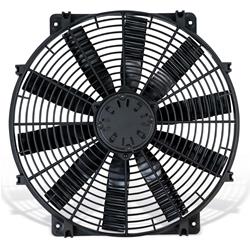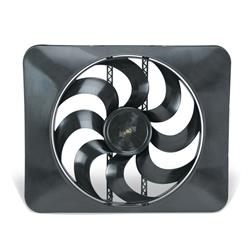I love you guys, but y'all going overboard here.
First, electric and belt fans have to be viewed from different mindsets. Belt fans use big blades spaced far apart. They need to be set back from the radiator a bit for air flow, but also so they don't contact the radiator when they flex or when the engine moves under torque. Electric fans can't really move as much air as a big belt driven fan, so they need a bit different engineering to function properly. It's a little like the difference between a tiny engine that spins to 10,000 rpm to make 100 hp, versus a 5.0L V8 spinning to 3000 rpm to make the same 100 hp.
First, take a look at the electric fans you have and then compare them to a belt-driven fan. Not only do those electric fan blades cover about half the real estate, the plastic grate behind it does as well. Electric fans are great at being active flow-generators, but often times horrible at allowing passive flow. Over on the hot rod forums, I wish I had a nickel for every time I heard someone's sob story about how they put this massive electric fan on their old car and now it overheats on the highway.
If you are doing a fan style like the ones you are showing, you will likely make things much worse with a shroud. Now you will be forcing passive air to go through those mesh baskets. You'll be effectively choking the passive airflow down to two small holes, each of them 50% blocked by plastic. If you think about it, a belt fan might move 4000 cfm when you're sitting in the driveway revving the engine, and it might move 10,000 while you're on the highway because you have all kinds of space for free-flowing air. The picture you show right now, if those fans can move 4000 sitting still, you might still be able to get that 10,000 cfm on the highway. If you put a shroud on it and force the air through the fans, they might move 4000 sitting still.... and 4500 on the highway.
To get the flow from electric fans, you either need a shroud with the fans pulled away from the radiator and some mechanism for a TON of bypass for free-flow, or you mount properly-sized fans tight up against the radiator with no shroud so you have free space beside them for free flow.
But forcing all of the air to go through those strainers is a recipe for overheating. The rated flow of a belt-driven fan and an electric fan are apples-to-apples when you're standing still. When you're moving, the big difference is that belt fans allow almost free-flow of ambient air, whereas electric fans tend to reduce the amount of free flowing air. The air being pushed through the grille is being slowed down by most electric fans.
It can be done, don't get me wrong. OEMs do it all the time. But they also have a million-dollar R&D budget. I have confidence that you can do it too, you just might be in for a fair amount of trial and error.
Clearance from the pulley to the fan? Not touching under torque. I put an electric fan in a 50 Ford with a Viper V10 and had about 1/8" clearance from the pulleys to the fans. The motor torques up/down/left/right, so as long as the engine torquing in those directions doesn't cause it to hit something protruding, don't stress.
I will also say this, and this is an extreme generalization. Fans designed like the ones you pictured are generally intended for either supplemental cooling, or for low speed applications. The basket blocks a ton of free-flow, but moves a good bit of air on its own. They're designed for street rods, buckets, and parade queens that need to generate lots of flow on their own, but they don't care how much free flow they block on the highway because a '29 model T with a 350 is going to spend most of its time going from the trailer to the grass in the park for the car show. They are also designed with blades that work best in low-clearance applications (minimal space) If you pull them away from the radiator, the shallow approach angle of the blades won't work as well in free-air hanging from a shroud.
For instance, here is a 3000 cfm electric fan that will probably work wonders for an overheating parade queen that never sees more than 35 mph. Put it on the highway and it will likely overheat in 5 miles.

Here is a 3300 cfm electric fan that might work for the parade queen, but on the highway it never has to turn on because it has all that free-flow area.

But if you take the style of the first fan, and stick it in a shroud like the second fan, you're defeating the benefits of both designs. The first fan gets whatever free-flow area it has because it DOESN'T have a shroud and air can flow through the radiator around it. If you put style A inside shroud B, you're doing two things: 1) taking the shallow-pitch fan blades away from the radiator making them less effective, and 2) blocking half of the flow area with a basket.















































